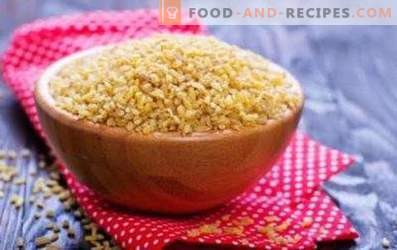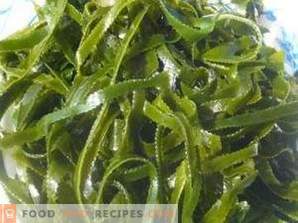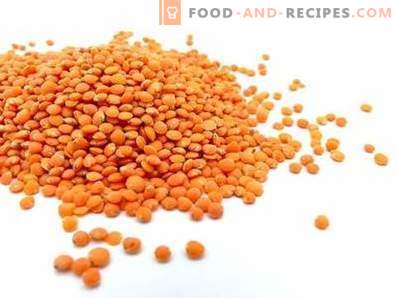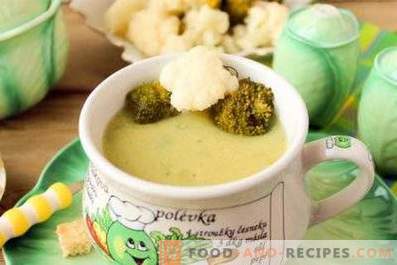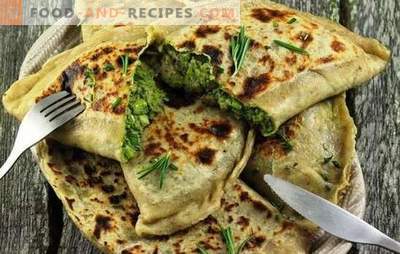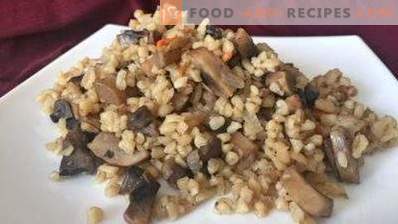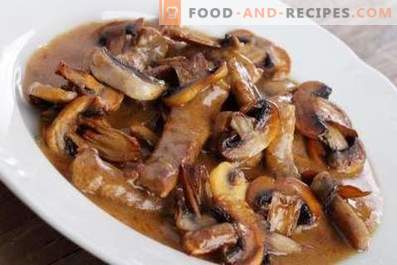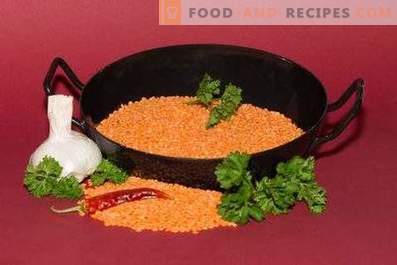
Lentils - perhaps the most ancient crop. The homeland of the plant is West Asia: according to researchers, local people began to cultivate it in the Neolithic era. For millennia, lentil seeds remained the most important source of vegetable protein and other nutrients necessary for the normal functioning of the body for Asian people.
Today, wild lentil species can be found in the countries of Central and Asia Minor, in the territory of South-Eastern Europe. At the same time, the largest producers and suppliers of the fruits of this plant to the international market are Canada, India, Turkey, Australia, USA and Nepal.
Lentils are eaten boiled and sprouted, used to make salads, first courses, vegetable cutlets and complex side dishes. In folk medicine, the fruits of the plant are used in the treatment of diseases of the nervous system, digestive tract and other pathologies.
Botanical description of lentils
Lentils - the culture belonging to the legume family. The pubescent branching stem of the plant reaches 70-75 cm in length. The pinnate leaves of lentils consist of 3-7 pairs of narrow oval leaflets up to 19 mm long and up to 8 mm wide. The culture in the middle of summer blooms with small purple, pink or white flowers.
Lentil fruit is a hanging bob of a diamond shape, reaching 8 mm in width and 11 mm in length. In each pod you can find 1-3 oblate seeds of a rounded shape. The color of the grains depends on the lentil variety and can vary from pale yellow or green to black.
Varieties of lentils
In cooking and alternative medicine most often used the following types of lentils:
- large brown, having a bright nutty taste and considered to be an excellent base for soups, vegetable casseroles;
- fine red, with a spicy nutty flavor, used to make leguminous puree, porridge;
- large greenish-black (French, “puy”) having a pronounced spicy taste, added to crumbly side dishes, vegetable salads;
- fine black, with a slight pea-nut flavor, used in the preparation of side dishes, salads, soups;
- green, representing the immature grains of the plant, which are used to prepare cold appetizers, salads;
- germinated.
It is possible to sprout lentil grains independently. To do this, rinse the cereal, pour it with lukewarm water, insist for 10-11 hours and place on a flat plate or tray with a thin layer. The lentil dishes should be covered with a moistened napkin made of cotton or linen and placed for 25-27 hours in a warm place, protected from sunlight.
Nutritional value of lentils and vitamins in its composition
Nutritional value 100 g of lentils:
- 23, 944 g of proteins;
- 1, 486 g of fat;
- 46, 298 g of carbohydrates;
- 11, 442 g of fiber;
- 2, 813 g of sugars (monosaccharides and disaccharides);
- 1, 808 g of sucrose;
- 43, 495 g of dextrins and starch;
- 13, 511 g of water;
- 2, 622 g of ash.
Vitamins in lentils (in 100 g of grains):
- A, retinol and other retinoids - 4, 917 μg;
- beta-carotene - 0, 028 mg;
- B5, pantothenate - 1, 191 mg;
- B1, thiamine - 0, 488 mg;
- E, tocopherol equivalent - 0, 442 mg;
- B9, folic acid - 89, 716 μg;
- PP, nicotinic acid - 5, 466 mg;
- niacin - 1, 762 mg;
- B2, riboflavin - 0, 209 mg.
Lentil calories
100 g of dry lentil grains contain 294, 012 kcal, in a tablespoon (23 g) - 67, 623 kcal, in a glass (210 g) - 617, 425 kcal. The caloric value of a 100-gram serving of boiled lentils is 111, 816 kcal, sprouted grains - 118, 713 kcal.
Useful items in lentils
Trace elements per 100 g of lentils:
- iodine - 3, 422 µg;
- molybdenum - 78, 002 mkg;
- iron - 11, 714 mg;
- zinc - 2, 417 mg;
- manganese - 1, 184 mg;
- fluorine - 24, 814 mkg;
- selenium - 19, 542 mcg;
- aluminum - 169, 121 μg;
- nickel - 162, 004 μg;
- chrome - 10, 712 mkg;
- cobalt - 11, 574 mcg;
- copper - 659, 472 mkg;
- titanium - 299, 014 mkg;
- boron - 609,842 mcg.
Macroelements per 100 g of lentil seeds:
- chlorine - 74, 117 mg;
- silicon - 79, 044 mg;
- sulfur - 162, 766 mg;
- magnesium - 79, 817 mg;
- calcium - 82, 197 mg;
- phosphorus - 389, 162 mg;
- potassium - 671, 804 mg;
- sodium - 54, 607 mg.
Benefits of Lentils
- Lentil grains can serve as a source of protein for people who are forced to eliminate meat and fish from their diets. Protein compounds of plant origin, present in the dishes prepared from them, are absorbed by the body much easier than animal proteins.
- Lentils are a rich source of fiber. Regularly eating this product, it is possible to reduce the likelihood of the development of disorders in the digestive tract, to accelerate the elimination of toxic substances from the body, to prevent the occurrence of constipation.
- Magnesium and other nutrients with which lentil grains are rich have a positive effect on the state of the vessels and the work of the heart, improve the blood supply to the tissues, activate oxygen metabolism, stabilize blood pressure and heart rate.
- Nutrients entering the human body when using lentils, stimulate the hematopoietic system. In order to increase the level of hemoglobin in the blood, it is enough to include porridge and other lentil dishes in the menu at least twice a week.
- Antioxidant substances, which rich lentil grains, slow down the processes associated with age-related changes in the body.
- Regularly incorporating lentil dishes into the ration, you can completely provide the body with folic acid and other B vitamins. systems, prevent the development of neurosis and nervous breakdowns, improve sleep.
- Retinol and other nutrients with which lentil seeds are rich prevent the development of age-related eye problems, protect the visual apparatus at elevated loads (for example, during prolonged work at the computer).
- Lentil is a source of tryptophan, an amino acid that is involved in the synthesis of the “happiness hormone” serotonin. People who eat lentil porridge at least twice a week, become less susceptible to irritants, less likely to suffer from depressive disorders and mood swings, tolerate stressful situations and emotional overload more easily.
- In traditional medicine, lentil flour is used to treat eczema and other dermatological diseases. A handful of ground cereal is poured with boiling water (400-450 ml), infused for 2, 5 hours and passed through a fine-mesh sieve. Every 4 hours irrigate the resulting fluid problem areas.
- Lentils contain a complex of nutrients that help remove excess cholesterol from the body. People who regularly include dishes from this product in the menu are less likely to experience atherosclerosis.
- Lentil grains and seedlings are rich in ascorbic acid and other compounds that strengthen the body's immune defenses, protecting it from infections during periods of epidemics.
- Regular consumption of lentils helps reduce the risk of polyp formation in the intestines.
- Lentils are rich in compounds with anti-carcinogenic properties. Cooked dishes from it help reduce the likelihood of developing cancer of the breast and intestines.
- Some varieties of lentils (including dish-shaped) contain substances that reduce the level of sugar in the blood. People who suffer from diabetes, it is useful to include lentil porridge in the diet at least twice a week.
- Ground lentils are used to relieve pain from burns. An ointment made from lentil flour and soft butter is applied on the diseased part of the skin.
- Lentils contain substances that accelerate tissue regeneration. That is why traditional healers recommend using an ointment made from lentil flour and egg yolk (1: 1) for the treatment of long-healing wounds.
- The complex of beneficial compounds present in lentils helps to ease the symptoms of menopausal syndrome. With regular consumption of lentils helps to normalize the menstrual cycle, increasing the likelihood of conception.
- Lentil grains have aphrodisiac properties, improve the composition of sperm, prevent the development of male infertility, reduce the risk of prostate gland diseases. Men who are faced with the problem of sexual impotence, it is recommended to include it in the diet at least every 3 days.
- It is noticed that lentil porridge helps to relieve pain in diseases of the urinary system.
- With excessive irritability, fatigue, and general weakness, it is helpful to drink a decoction of lentils. For its preparation it is necessary to boil 1/2 cup of dry grains in 700 ml of water for 35 minutes.
Contraindications and harm to lentils
- Lentils - a potential allergen. People who have previously been detected hypersensitivity reactions to leguminous plants, should exclude lentils from the diet.
- Abuse of lentils leads to abdominal distention, increased gas formation, diarrhea, and kidney disease.
- Lentils are rich in oxalate compounds that cause the formation of kidney stones.
- Lentil croup is contraindicated in people suffering from gout, intestinal dysbiosis, biliary dyskinesia.
- Lentils in elevated concentrations contain phytates - compounds that inhibit the absorption of minerals in the human body and inhibit the action of digestive enzymes.






